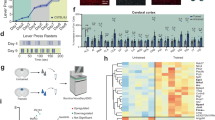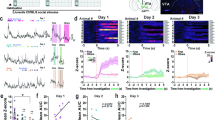Abstract
Instrumental conditioning allows animals to learn about the consequences of their own actions, but the underpinning molecular mechanisms remain elusive. Here we show that the sphingosine-1-phosphate (S1P) receptor Gpr6 is selectively expressed in the striatopallidal neurons in the striatum. Gpr6-deficient mice showed reduced striatal cyclic AMP production in vitro and selective alterations in instrumental conditioning in vivo. Thus, Gpr6 is the first striatopallidal neuron–specific genetic regulator of instrumental conditioning in a mammal.
This is a preview of subscription content, access via your institution
Access options
Subscribe to this journal
Receive 12 print issues and online access
$209.00 per year
only $17.42 per issue
Buy this article
- Purchase on Springer Link
- Instant access to full article PDF
Prices may be subject to local taxes which are calculated during checkout


Similar content being viewed by others
References
Balleine, B.W. & Dickinson, A. Neuropharmacology 37, 407–419 (1998).
Schultz, W., Dayan, P. & Montague, P.R. Science 275, 1593–1599 (1997).
Balleine, B.W. Physiol. Behav. 86, 717–730 (2005).
Gerfen, C.R. Annu. Rev. Neurosci. 15, 285–320 (1992).
Albin, R.L., Young, A.B. & Penney, J.B. Trends Neurosci. 12, 366–375 (1989).
Lobo, M.K., Karsten, S.L., Gray, M., Geschwind, D.H. & Yang, X.W. Nat. Neurosci. 9, 443–452 (2006).
Uhlenbrock, K., Gassenhuber, H. & Kostenis, E. Cell. Signal. 14, 941–953 (2002).
Ignatov, A., Lintzel, J., Kreienkamp, H.J. & Schaller, H.C. Biochem. Biophys. Res. Commun. 311, 329–336 (2003).
Lein, E.S. et al. Nature 445, 168–176 (2007).
Gong, S. et al. Nature 425, 917–925 (2003).
Day, M. et al. Nat. Neurosci. 9, 251–259 (2006).
Kreitzer, A.C. & Malenka, R.C. Nature 445, 643–647 (2007).
Everitt, B.J. & Robbins, T.W. Nat. Neurosci. 8, 1481–1489 (2005).
Hyman, S.E., Malenka, R.C. & Nestler, E.J. Annu. Rev. Neurosci. 29, 565–598 (2006).
Acknowledgements
We would like to thank B. Leung for technical support, C. Evans, N. Maidment and A. Charles for discussions and help in the project, and C. Evans and K. Roberts for met-enkephalin antibody and for assistance in cAMP assays. We also thank Deltagen for the Gpr6−/− mice, and N. Heintz (Rockefeller University) and the US National Institute of Neurological Disorders and Stroke Gene Expression Nervous System Atlas Project and Mutant Mouse Regional Resource Center for the Drd1-, Drd2- and Gpr6-GFP mice. This work was supported in part by pilot grants from the University of California, Los Angeles Hatos Center for Neuropharmacology, grants from the US National Institute on Drug Abuse (P50DA05010) to X.W.Y., grants from the US National Institute on Mental Health (MH56446) to B.W.B., and a University of California, Los Angeles Mental Retardation Research Center training grant from the US National Institute on Child Health and Human Development (5T32HD007032) to M.K.L.
Author information
Authors and Affiliations
Contributions
M.K.L. conducted all phases of the experimental work and data analyses, except for the instrumental conditioning studies, and contributed to writing the manuscript. Y.C. contributed to the instrumental conditioning studies. S.B.O. contributed to manuscript preparation and to the data analysis of the instrumental conditioning studies. X.W.Y. and B.W.B. were responsible for the overall design of the project, analyses of the results and writing of the manuscript.
Corresponding authors
Supplementary information
Supplementary Text and Figures
Supplementary Figures 1–5 and Methods (PDF 3586 kb)
Rights and permissions
About this article
Cite this article
Lobo, M., Cui, Y., Ostlund, S. et al. Genetic control of instrumental conditioning by striatopallidal neuron–specific S1P receptor Gpr6. Nat Neurosci 10, 1395–1397 (2007). https://doi.org/10.1038/nn1987
Received:
Accepted:
Published:
Issue Date:
DOI: https://doi.org/10.1038/nn1987
This article is cited by
-
Update on GPCR-based targets for the development of novel antidepressants
Molecular Psychiatry (2022)
-
A distinct D1-MSN subpopulation down-regulates dopamine to promote negative emotional state
Cell Research (2022)
-
DNA methylation and hydroxymethylation characterize the identity of D1 and D2 striatal projection neurons
Communications Biology (2022)
-
GPR3, GPR6, and GPR12 as novel molecular targets: their biological functions and interaction with cannabidiol
Acta Pharmacologica Sinica (2019)
-
Neuro-psychopharmacological perspective of Orphan receptors of Rhodopsin (class A) family of G protein-coupled receptors
Psychopharmacology (2017)



